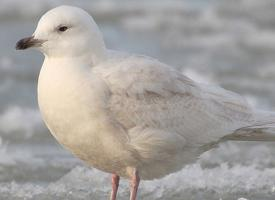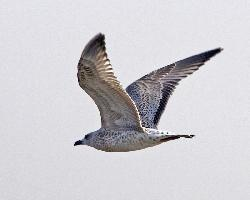
Veszélyeztetettség
| Veszélyeztetett |
Állatleírás
The Iceland Gull (Larus glaucoides) is a captivating species of bird that belongs to the family Laridae, which encompasses gulls, terns, and skimmers. This species is particularly notable for its beautiful plumage, relatively large size, and the intriguing variations in its appearance across different life stages and seasons. Found predominantly in the North Atlantic, from the eastern coast of Canada and Greenland to parts of Europe and the British Isles, the Iceland Gull is a migratory bird that often travels southward during the winter months, reaching as far as the northeastern United States.Adult Iceland Gulls are distinguished by their predominantly white plumage, which is accented by light grey back and upper wings. The wingspan of an adult can stretch impressively between 125 to 148 cm, showcasing broad, powerful wings that are adept at navigating the harsh climates of the North Atlantic. One of the most striking features of this species is its pure white tail, which lacks the black band commonly found in many other gull species. The bird's bill is yellow and features a red spot on the lower mandible, a characteristic shared with several other gull species. The legs of the Iceland Gull are also pink, adding a subtle touch of color to its otherwise monochromatic appearance.
Juvenile Iceland Gulls exhibit a mottled brown and white plumage, which gradually lightens as they age over the first two to four years of their lives. This transformation is a fascinating process, as the birds transition through various plumage stages, each offering a unique blend of patterns and colors until they achieve the full adult plumage.
In terms of behavior, Iceland Gulls are opportunistic feeders, with a diet that includes fish, crustaceans, mollusks, and a variety of other marine organisms. They are also known to scavenge, taking advantage of food sources provided by human activity, such as waste from fishing boats or landfills. This adaptability in feeding habits ensures their survival in the diverse environments they inhabit throughout the year.
Breeding typically occurs in colonies on the coasts and islands of the North Atlantic, with nests constructed on the ground, often on cliffs or in other sheltered locations. The Iceland Gull lays two to three eggs, which are incubated for about four weeks. Both parents share in the duties of incubation and rearing the young, demonstrating a strong parental investment in the survival of their offspring.
The Iceland Gull, with its serene appearance and graceful flight, is a symbol of the rugged and unspoiled landscapes it inhabits. Despite facing threats from pollution, climate change, and changes in food availability, the species has managed to maintain stable population levels in many areas, though conservation efforts are important to ensure its continued presence in the delicate ecosystems of the North Atlantic. The Iceland Gull remains a subject of interest for birdwatchers and researchers alike, who are drawn to its beauty, its complex life cycle, and its adaptability to the challenging environments it calls home.
Hasonló állatok
Új állatfotók
Top 10 állat
- Dolphin gull (Leucophaeus scoresbii)
- Diana monkey (Cercopithecus diana)
- Moustached guenon (Cercopithecus cephus)
- Galápagos tortoise (Geochelone nigra complex)
- Japanese macaque (Macaca fuscata)
- Stone loach (Barbatula barbatula)
- Russian tortoise (Testudo horsfieldii)
- Greek tortoise (Testudo graeca)
- Common flying dragon (Draco volans)
- Vendace (Coregonus albula)


